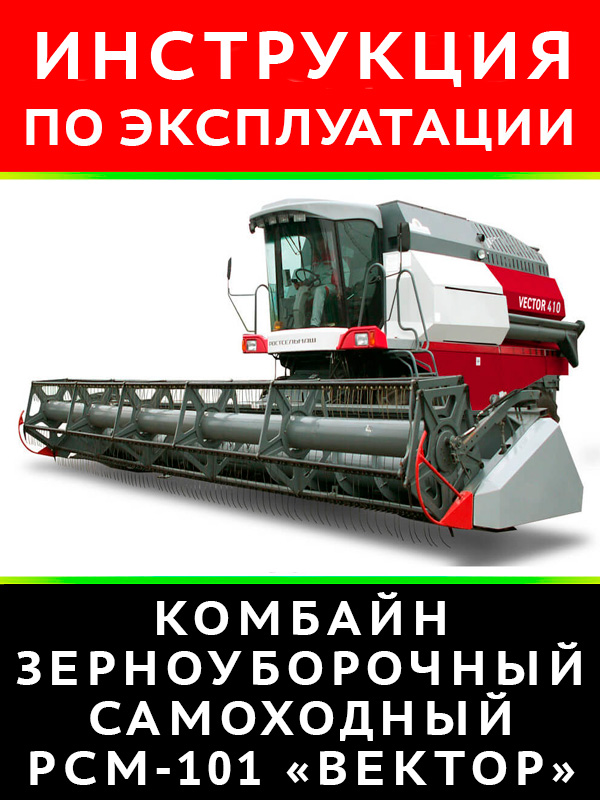
| Contents
Introduction
General information
Before starting
General description and technical characteristics
Purpose and scope
Combine equipment
Design features
Additional equipment
Rating plates and serial numbers
Brief information about the device of the combine
Combine composition
Direct combining technological process
Technological process of picking up swaths by the pick-up platform
Basic technical data
Security requirements
Plates (applications) with warning and prohibition signs and notices
Safety instructions
Intended use
Safety rules for unloading from a railway platform
General safety instructions
Safety requirements when driving
Safety precautions when using the header cart
Safety rules when carrying out adjustment or repair work
Fire safety rules
Controls and devices
Workplace
Steering column
Control panel
Fuel management
Combine motion control
Range box control
Combine control panel PU-101-03
PUM-02 reel rotation control panel
Information panel
Panel purpose
List and designation of pictograms
Getting Started PI
UI setup
Controlling the brakes and locking the range box
Parking brake control
Lighting and signaling devices
Microclimate devices
Combine mechanisms control using electrohydraulics and electromechanics
Additional assembly, commissioning and running-in on site
General provisions
Harvester reassembly
General assembly instructions
Installation of hydraulic equipment
Feeder house reassembly
Mounting the header on the combine
Assembling the loader
Chopper preparation
Trailer assembly
Stacker installation
Installation of electrical equipment
Installing primary converters
Installation of fire extinguishers
Installation of the state registration plate
Brake performance test
Running in
Preparing for running in
Recommendations for filling the hydraulic equipment of the combine with oil
Toe-in setting
Dry running (no load for 2.5 hours)
Running in operation (within 60 hours)
Rules of operation and regulation
General instructions for using the combine
Working order of the header
How the pick-up platform works
Adjustments to ensure process stability
Setting gaps
Thresher operation
General instructions for preparing the thresher for work
Thresher drive mechanism
Installation of the threshing device clearance adjustment mechanism
Drum variator
Cleaning fan speed control
Blinds opening adjustment
Feeder House Drive On / Off Adjustment
Straw walker assembly features
Threshing device repair
Hopper and unloading device
Conveying devices
Re-equipment of the harvester thresher with devices for threshing sunflower and corn for grain
Conversion of the feeder harvester chamber to devices for harvesting corn for grain
Workplace operation
Cab
Seat
Login area
Ladder
Hydraulic equipment operation
Steering hydraulic system
Hydraulic volumetric hydraulic drive
Before the daily start-up of the hydraulic system of the volumetric hydraulic drive (hereinafter GST), it is necessary
Replacing filter elements
Replacing Hydraulic Oil on Combine
Filling the hydraulic system
List of filters and filter elements
Notes on protecting the hydraulic system from contamination during operation
Feeder House Lowering Speed ??Setting
Operating the motor unit
Engine cooling water
Cleaning the radiator
Oil drain
Draining condensation water, dirt and rust from the fuel tank
Motor unit with Cummins engine
Mechanism for setting the neutral position of the control lever (Neutral control mechanism. Motor unit with GTS "Linder"
Running undercarriage
Using ranges
Adjusting the speed of the combine
Features of disassembling MVK
KP management
Adjustments (CIT and ZF)
Adjustment of the gearbox control system at the CLAAS MVK
Stacker operation
How to work with IRS
How to work with the control system
Bearing support operation
Transportation and towing rules
Transportation of harvesters by rail
Moving the combine with the header
Instruction for towing harvesters in economic conditions (with the engine off)
Maintenance
General information
List and recommended order of performance of work for each type of maintenance
Maintenance during transportation by its own power
Shift Maintenance (ETO)
First maintenance (TO-1)
Second maintenance (TO-2)
Storage combine maintenance
Removal maintenance
Technical requirements for the main assembly units and systems of the combine
Combine lubrication
Storage rules
General instructions
Preparing the combine for storage
Storage of the combine and its components
Tire storage
Engine storage
Storing the stacker
Hydraulic equipment storage
Removal from storage
Possible malfunctions and methods of their elimination
Applications
Appendix A list of spare parts, tools and accessories
Appendix B hydraulic schematic diagram
Appendix C electrical schematic diagram
Appendix D belt and chain drives
Appendix E operation of bearing arrangements
Appendix F recommended threshing modes for optimal harvesting conditions
Appendix G volumes of refueling tanks and recommended brands of fuels and lubricants |